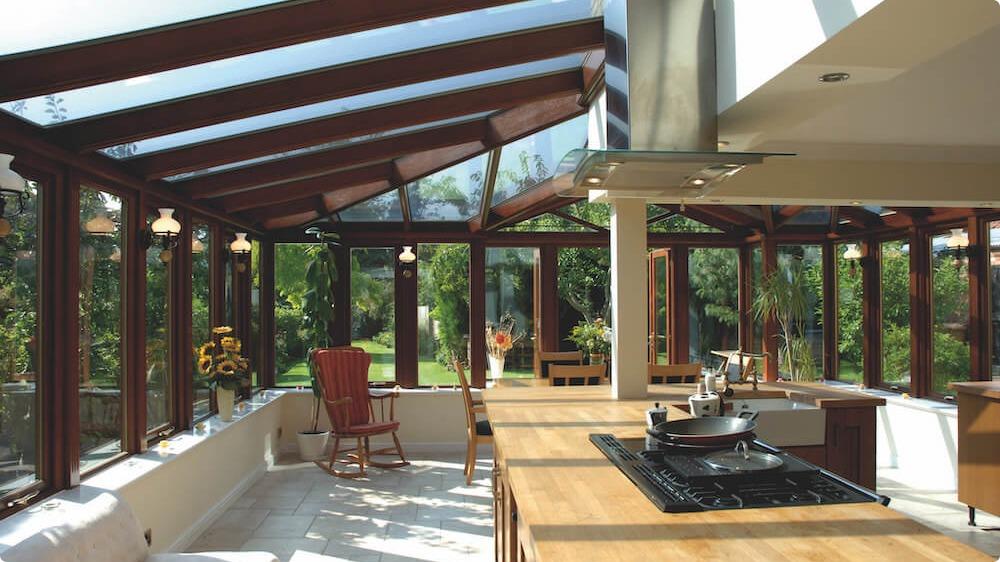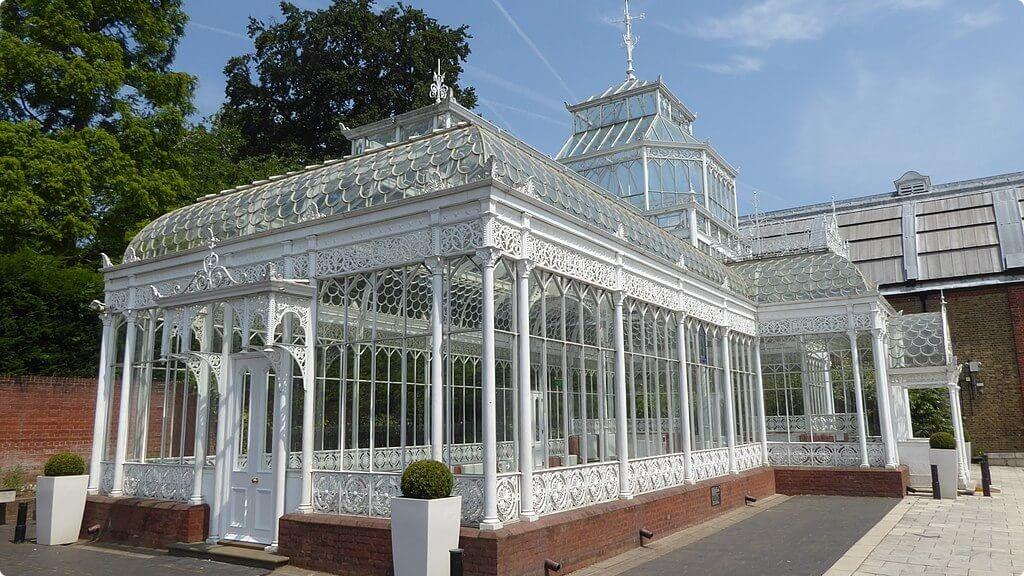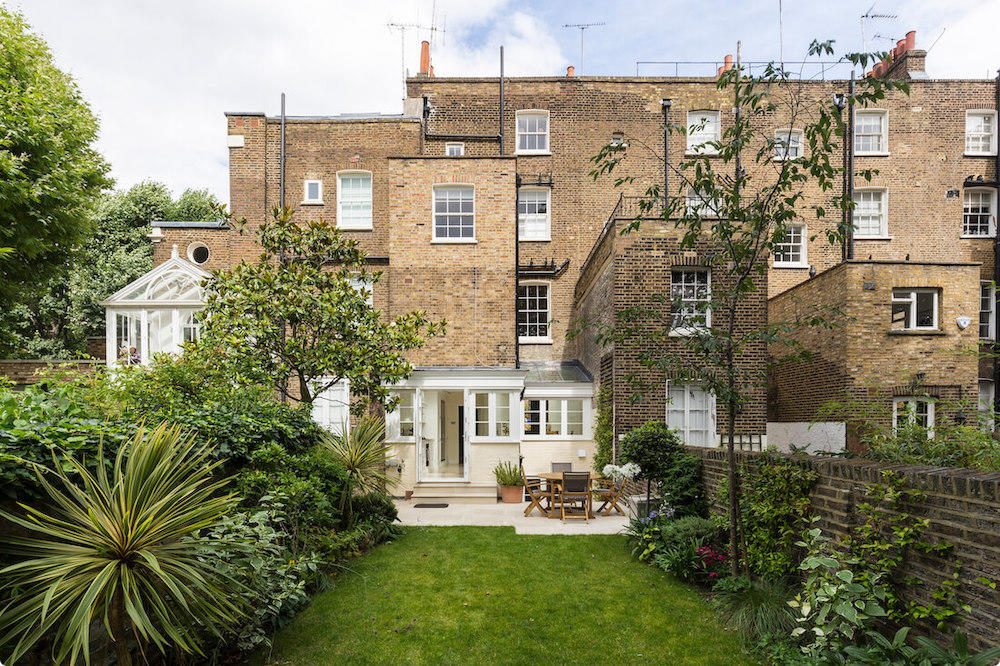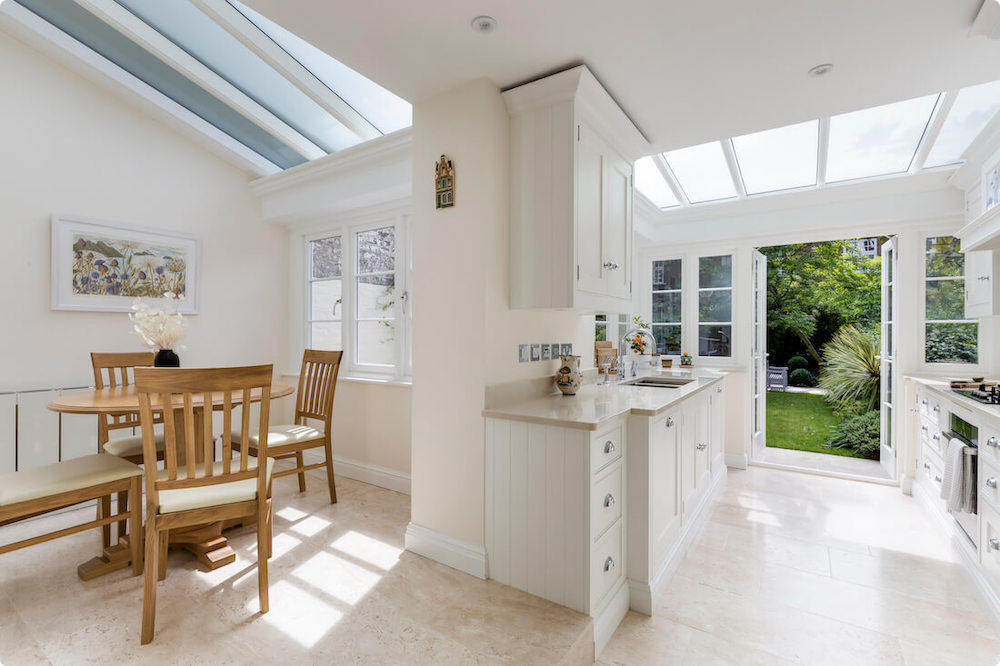Building a conservatory is a popular way to expand your kitchen while flooding it with natural light. The ample natural light and ability to seamlessly connect with the outdoors has made it a favourite amongst many homeowners.
Many modern homes blend the kitchen with a conservatory to be one large open-plan family space. This multifunctional space is perfect for enjoying family meals, entertaining guests, or even spending time with yourself and nature.
In this post, we’ll be looking at the types of conservatory kitchen extensions, their cost, building regulations, planning permission and, of course, some kitchen conservatory ideas.
And if you’re raring to go already, you can get a kitchen extension design quote here.
What is a conservatory kitchen extension?
A conservatory kitchen extension has at least two-thirds of its roof made from glass and a minimum of half its wall area made from glass or translucent plastic.
The major difference between conservatories and orangeries lies in how their roofs are constructed — specifically how much glazing is involved. Where the roof of a conservatory tends to be more glass, an orangery will have less glazing and a lantern shaped roof.
Conservatory kitchen ideas
The inspiration behind a kitchen conservatory extension is to seamlessly connect the kitchen and dining area to the garden. There are several ways to achieve this. Let’s take a look at some great ideas for creating your perfect conservatory kitchen extension.
Use bi-fold doors to connect the kitchen to the garden
Bi-fold doors will create a wide access point that opens up to the lovely view of the garden, letting in more light while creating a perfect view for entertaining guests.
Open plan kitchen conservatory
Creating an extension that connects seamlessly to your home is another excellent idea. Although removing your walls may seem daunting, it can help make your conservatory extension the focal point of your home.

An open plan conservatory kitchen | Photo by Lizzie Benton
Lean-to conservatories
As the name suggests, this style of conservatory has the extension running against your rear wall, keeping the original brickwork in place. The overall effect is one where the extension looks like it is leaning against the existing building, and with plenty of glass, this can be a great way of preserving the original wall of your home. Not only this, a lean-to has much structural support, on top of providing better insulation for the rest of the home.
P-shaped kitchen conservatory
A P-shaped conservatory is constructed by combining elements of a victorian style conservatory with those of a lean-to conservatory so that together they form a P. The idea behind a P-shaped conservatory extension is to maximise the potentially limited space you may have with your new kitchen extension while still achieving a visually stunning design.
Small conservatory kitchen
If you haven't much space, you could still install a conservatory as a means of brightening up a dark kitchen diner. You could opt for a lean-to conservatory extension with bi-fold windows so that your kitchen can open up to a small garden area.
Embrace the history
Conservatories have been around for a while and come in all sorts of historical shapes and sizes. You could take inspiration from the ornate Victorian conservatories, still seen in many historic gardens. Or you might even explore Georgina and Edwardian styles, all of which play with the metal framework, roofing and glass. Explore a domed roof or even some filigree details to get that real period touch.

Photo by Marathon / The Victorian Conservatory at Horniman Gardens
Building regulations for kitchen conservatory extensions
Of all the building regulations on conservatory kitchen extensions, the most applicable is the 25% rule in Part L, which states that nothing more than 25% of the new extensions floor area may be opening or glazing. This rule is stipulated to maintain thermal efficiency as glazing is not as thermally efficient as solid walls.
Any individual desiring to achieve a highly glazed kitchen extension by going past the 25% mark will have to submit a building regulations application that can only be approved after proving that the extension meets requirements for thermal efficiency.
Besides the 25% rule, you should also consider other building regulation matters like structure, ventilation, sound-proofing, plus other matters your structural engineer or architectural technician will be able to walk you through.
To ensure your project is compliant, you should talk about your project to a Resi expert.
Do I need planning permission for a conservatory?
Conservatories fall under permitted development rights and, therefore, they can be installed without a full planning application if they follow the stipulated specifications.
These include...
- Only half the area of land around the "original house" can be covered by extensions or other buildings
- Extensions cannot be higher than the highest part of the existing roof; or higher at the eaves than the existing eaves
- Where the extension comes within two metres of the boundary, the height at the eaves cannot exceed three metres
- Extension cannot be built forward of the ‘principal elevation’ or, where it fronts a highway, the ‘side elevation’
Please note, permitted development rights do not apply to maisonettes, flats, and listed buildings and are limited for houses in conservation areas.
How much does a kitchen conservatory extension cost?
The biggest factors in determining your budget will be...
- Size
- Materials
- Location
- Design
The cost of your conservatory kitchen extension will also be significantly impacted by your design plan. Will you be installing kitchen appliances and fixtures into the conservatory part of the room, or are you simply using the conservatory to open up your kitchen area?

A modest conservatory kitchen extension in London, completed in 2015 in a conservation area.
Although building a conservatory is generally cheaper than building an extension, the cost of a kitchen conservatory extension will increase due to the extra expenses that come with fitting a kitchen.
While a lean-to conservatory with basic kitchen appliances would cost an average of £15,000 to construct, an Edwardian style conservatory could cost an average of £18,500.
Please note: that the figures stated above are subject to change and only cover the cost of construction, not the professional fees required by engineers or architects, or council fees. We recommend using our construction cost estimator to determine your project’s cost.
The major steps to building your kitchen conservatory
Before you start approaching builders, it's recommended that you get the necessary admin work out of the way first. This will include…
- Securing planning approval or (if using your permitted development rights) a lawful development certificate
- Hiring a structural engineer and (ideally) putting together a building regulations package
- Sorting any party wall matters
Once you’ve ticked this list off and you’ve found a trusted contractor, then your build can begin. Conservatories are less intensive than other kitchen extensions, so tend to be completed in less time. And if yours is being mainly off-site, these timings could be reduced to just a couple of weeks, saving you from living off-site for a lengthy period of time.
Most conservatory builds will include these major steps…
- Laying out your foundations and pouring the concrete
- Building up the brickwork to the damp course level, ensuring it will be level at the end
- Setting down your concrete flooring
- Getting walls in place, either brick by brick or by fitting the preconstructed elements
- Fitting your doors
- Adding in your roof rafters and then laying down the glazing
- Fitting guttering
- Plumbing and electrical fit-outs
- Final finishes and making good on the construction site
The pitfalls to avoid when opening up a kitchen into a conservatory
Conservatories aren’t perfect and they can easily cause more havoc than they’re worth, especially if you get your glazing or frames wrong. So, how to ensure your conservatory extension is up to scratch? Here are some top tips from our designers.

Frosted glass has been used on the roof of this conservatory extension to retain privacy in a built up area.
uPVC frames are some of the cheapest on the market, but there is a reason for this. They’re difficult to repair and degrade more easily than their timber or aluminium counterparts. Their dated look has also gone out of fashion, so you won’t see a big return on investment for this style of conservatory.
Kitchens get steamy, what with all the boiling pots and cooling baked goods. Therefore, you need to make sure you prioritise good ventilation. Otherwise, all that glass is going to steam up, create lots of condensation and this can lead to mould.
If you’re opting for an open kitchen extension, check your boiler can handle heating such a big space. It could be that you need to upgrade or consider alternative heating options, such as the eco-friendly heat pump system or underfloor heating.
Conservatories are notorious for the greenhouse effect, whereby they’re too hot in summer and too cold in winter. You can offset this by investing in high-quality glazing. Solar control treatments will keep temperatures mild on sunny days, while double (or even better, triple) glazing will make sure heat is retained in those colder months.
Other important considerations
One major challenge associated with conservatories is thermal efficiency. The excessive expanse of glass used in their construction can leave your room at the risk of overheating in summer and being too cold in winter.
To prevent your space from overheating, you should consider one or more of the solutions below.
- Ensure the extension is strategically situated. Extensions facing south are exposed to a lot of natural light most of the day, while those facing north tend to be shadier and would benefit more from the extra light supplied by the kitchen conservatory
- Another effective - albeit pricey - preventive method is installing solar control glass. This glass has a microscopically thin coating that reflects heat from the sun outside
- Last but not least, you should consider investing in blinds. Installing blinds will block out excess sunlight while keeping the conservatory extension cool
As far as insulating the conservatory goes, we recommend underfloor heating because it’s more energy efficient. It doesn’t require wall space like traditional radiators and can effectively eliminate cold spots.
Installing a conservatory kitchen extension can be a lot of work, and Resi is here to take the weight off your shoulders. We can introduce you to vetted contractors in your area, to help you choose the right person for your project.
You can start exploring your financing options by using our Resi Finance calculator.
























